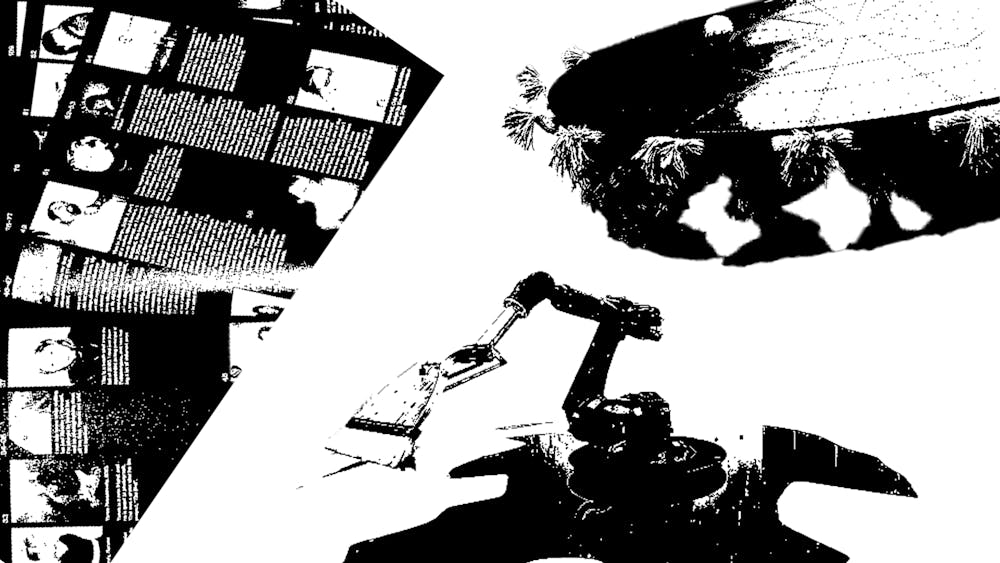The way we interpret art informs our connection with it. From one person to another, our interpretations may differ, but one thing remains the same—art is, at once, both our emotional window and mirror. The most beautiful things about art are the endless ways it can be formed and understood. Often, it feels like the blank canvas is the only medium through which the complexity of our emotions can be captured; amongst the worst of them, existentialism. It allows for an avenue through which existential dread, or existential euphoria (hair pulling, amongst other things) can be reflected upon and even created.
This emotion has stood the test of time, finding its way into some of today’s most popular art pieces like the “Can’t Help Myself” robot or “Round Table.” Such artwork seems to perfectly capture what it feels like to be isolated in this uncertainty in ways that no other popular form of media can. The connection between art, existentialism, and “adulting” seems like such a niche and odd phenomenon, but really, consuming art has always been highly personal. Through the test of adulthood, in fact, “art”—reliable and understanding—becomes a friend.
The “Can’t Help Myself,” robot, for starters, was fawned over by the public in November 2021. It works solely to contain a thick, red liquid in a specific area, but each time it sweeps one section, another expands. An endless cycle of cleaning up, spreading, and repeating, making no headway in cleaning up the mess. Sound familiar?
Some of the most resonating emotions viewers felt while watching this robot’s plight to an end were sympathy and sadness: one commenter even stated, “No piece of art has ever emotionally affected me the way this robot arm piece has.” Yet, it isn’t Ivan Kramskoi’s “Inconsolable Grief,” or even Edvard Munch’s “The Scream.” It’s a robot arm, and it’s one of the most emotionally effective pieces of this decade.
Head–scratcher.
It’s interesting that some of the most popular interpretations of this piece are the furthest from its original meaning. The description from the Guggenheim Museum, its container, states that it works to “examine our increasingly automated global reality, one in which territories are controlled mechanically and the relationship between people and machines is rapidly changing.”
How, then, did we get from automation to existentialism?
Hypercritic calls the piece a depiction of a “Sisyphean task;” one that is worked on endlessly without completion, ever. The emotions arising from such tasks speak to the young demographic that clenches their jaws through endless job applications; that cries while trying to find their footing on an ever–changing world; that can only seem to relate how pointless life seems to be through a robot exhibiting nearly human qualities.
This art piece is hardly the first in which viewers felt a true connection with a piece that seemingly summed up their real–world qualms. “Round Table” by Choe U–Ram has garnered a similar sort of fascination. In it, eighteen straw figures uphold a table with a singular ball. Each time the ball nears one sculpture’s edge, they stand in an attempt to claim it for themselves, only for the ball to roll to the other side. Choe himself stated the work is open to interpretation, yet many connect it to representations of modern–day social dynamics; among such, a constant pursuit of success.
There’s a recurring theme in contemporary art. People can interpret it however they want, but the primary, 20–something demographic of contemporary art continually relates to the sense of helplessness in these entirely non–sentient beings; whether they be robots or straw people.
The theme of existentialism is nothing new to art. However, we often get caught up in our dread of the future and forget the beauty of youth. There’s something special about the future being unknown, and an appreciation of this uncertainty is beginning to garner more attention—Fryd Frydendahl’s “Salad Days” exemplifies such. Her photo book captures the simple, forgotten things about finding your real–world footing: the innocence, the lack of conviction, and above all else, the youthful ignorance.
We attempt to feign confidence about our lives and forget that we’re allowed to be ignorant of what the future holds. We’re allowed to be clueless sometimes. When entering adulthood, we’re once again like toddlers, learning how to put one foot in front of the other. It can feel frustrating. Lonely. Dejecting. Yet, modern art does well with exemplifying these exact struggles; it’s only natural, then, that we form connections to such pieces that can often tread a very personal line.
Though, it helps to know that there are others just like us: others merely watching a robot unable to help itself; or squinting to understand Sisyphean straw figures; or decoding some other art piece that, though inhuman, somehow captures the complexity of what it means to be such a being.







